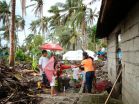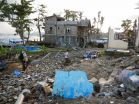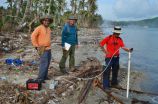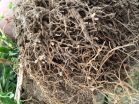(Press-News.org) In research of significance to the world's expanding coastal populations, scientists have found that geology and infrastructure play key roles in determining whether aquifers that provide drinking water are inundated with seawater during a typhoon or hurricane and how long the contamination lasts.
In 2013, Typhoon Haiyan devastated the Philippines, killing more than 6,000 people and destroying nearly $3 billion worth of property. While the country is still recovering from the storm, researchers with The University of Texas at Austin have found that an aquifer on the island of Samar inundated with salt water by the storm surge could remain undrinkable for up to 10 years. But a second aquifer on the island that was also inundated has recovered much more quickly.
The research was published online April 14 in the journal Geophysical Research Letters. It focused on aquifers used by the village of San Antonio on the island of Samar.
The difference in recovery time is due to the two aquifer's surrounding geology, said Bayani Cardenas, an associate professor in the Department of Geological Sciences in the Jackson School of Geosciences, who led the research team. The shallower of the two aquifers is made up of beach sand about 10-15 feet deep, which allowed the salt water soaked up from the surge to percolate to the water table and move through the aquifer for years to come. In contrast, the other aquifer is largely shielded from seepage because of its depth and possibly an overlying layer of volcanic rock.
"There are two types of aquifers, contaminated in two different ways," Cardenas said.
The findings are an important insight into what makes aquifers vulnerable to storm surge contamination and contamination's lasting effects, a topic that's expected to become especially important to coastal populations as storms become stronger and more frequent because of climate change, Cardenas said.
"Typically, when people think of flooding or sea level rise, they look at how it's going to drown out villages and roads, but all these effects propagate underground where the aquifers are," Cardenas said.
The UT Austin team also included geosciences professor Philip Bennett and graduate students Peter Zamora, Kevin Befus, Matt Kaufman and Aaron Jones. The team collaborated with Raymond Rodolfo, Hillel Cabria and Mark Lapus from a Filipino environmental consulting company, a local aid group, and leaders and residents from the village.
Sponsored in part by the Jackson School's rapid response program, a fund that supports research in areas recently affected by natural disasters, the researchers arrived in San Antonio two months after the storm struck. The team took water samples from dozens of village wells that tapped into the aquifers.
The researchers found the wells contained a median seawater concentration of 4.5 percent, with some containing as much as 17 percent seawater. In comparison, U.S. environmental standards set the concentration for drinking water below 1.3 percent.
When the team returned six months later, thanks to support from the U.S. National Science Foundation, researchers found the salinity of the deeper aquifer was within drinkable levels, while wells to the shallower aquifer remained too salty to drink. Using a computer model and villager testimony, researchers determined that water reached the aquifers in different ways.
For the deeper aquifer, the contamination most likely came from salt water entering through wells flooded by the storm surge. However, the fact that the contamination came all at once enabled it to be mostly swept out of the area en masse by freshwater naturally flowing through the aquifer and out to sea. The majority of the village's wells tap into the deeper aquifer, where water salinity now is largely within drinkable levels. However, bacterial contamination, which the storm surge may have contributed to, remains an issue.
For the shallower aquifer, the model showed contamination is occurring in gradual doses, as the saltwater seeps through the sand to the water table.
"It slowly percolates," Cardenas said. "So that's the one that will take longer to recover."
The saltwater may also reach the deeper aquifer through percolation, but it will be at more dilute concentrations.
These findings show that coastal aquifers -- and the people who depend on them -- could be at risk of contamination in future storms.
"Since growing coastal populations will continue to rely on groundwater for their needs, strategies for reducing vulnerability to intense storm surge-caused groundwater contamination and mitigating its effects are needed," the researchers stated in the study. "Below-ground aquifer devastation from storm surge is unseen but need not be unforeseen."
INFORMATION:
PULLMAN, Wash. - A team of international scientists has shown that assigning a dollar value to the benefits nature provides agriculture improves the bottom line for farmers while protecting the environment. The study confirms that organic farming systems do a better job of capitalizing on nature's services.
Scientists from Australia, Denmark, New Zealand, the United Kingdom and the United States describe the research they conducted on organic and conventional farms to arrive at dollar values for natural processes that aid farming and that can substitute for costly fossil ...
As HIV investigators work to control and eradicate the virus worldwide, certain myths or misconceptions about the disease have been embraced, whereas other concepts with merit have been left relatively unexplored, argues American HIV/AIDS researcher Jay Levy, MD, in a commentary publishing April 14 in the journal Trends in Molecular Medicine. He calls on fellow researchers to continue questioning and not to lose sight of alternative strategies that could ultimately lead to a sustainable, long-term solution to HIV infection.
"This paper may be controversial, but people ...
You might think that you can get away with eating fatty foods for a few days without it making any significant changes to your body.
Think again.
After just five days of eating a high-fat diet, the way in which the body's muscle processes nutrients changes, which could lead to long-term problems such as weight gain, obesity, and other health issues, a new study has found.
"Most people think they can indulge in high-fat foods for a few days and get away with it," said Matt Hulver, an associate professor of human nutrition, foods, and exercise in the Virginia Tech College ...
This news release is available in German. Looking after yourself, and trying not to infect others, is a good strategy to prevent disease from spreading - not only if you are a considerate co-worker, but also if you are an ant, meerkat or other social animal, as revealed by an epidemiological model developed by the groups of Professor Fabian Theis from the Helmholtz Center Munich and Professor Sylvia Cremer from the Institute of Science and Technology (IST) Austria. In a Theme Issue of the Philosophical Transactions of the Royal Society B on "The Society-Health-Fitness ...
This news release is available in Spanish and Spanish.
Combination of the anticancer drug PM1183 with PARP inhibitors and doxorubicin results in a synergistic effect against breast cancer cell lines and a SCLC mouse tumor model, respectively.
The anticancer candidate plitidepsin binds to eEF1A2, a novel therapeutic target in multiple myeloma, and shows activity in patient-derived tumor mouse models from a wide range of solid tumors and hematological cancers.
The new antibody-drug conjugate (ADC), MI130004, shows in vivo potent and long-lasting anticancer effects ...
New research from the University of Warwick and University Hospitals Coventry and Warwickshire (UHCW) NHS Trust could transform treatments and diagnosis for a common digestive condition which affects thousands of patients.
The oesophagus or food pipe (gullet) is part of the digestive system. It is the tube that carries food from your mouth to your stomach. Barrett's Oesophagus (also known as BE) and low-grade dysplasia affects approximately 2% of the adult population, particularly those with heartburn, as acid reflux from the stomach can, over time, damage the lining ...
When it comes to supramolecular chemistry, the carboxylic acid group (and its conjugate carboxylate base) is one of the chemist's most flexible friends. In pairs, they act as supramolecular synthons from which more complicated structures might be built but also offer up complex hydrogen bond connectivity. Luigi D'Ascenzo and Pascal Auffinger of the University of Strasbourg, France [D'Ascenzo, L. & Auffinger, P. (2015), Acta Cryst. B71, 164-175; doi: 10.1107/S205252061500270X], point out that until now there has been no exhaustive classification of these carboxyl(ate) motifs ...
WASHINGTON, D.C., April 14, 2015 - A team of Finnish scientists has found a new way to examine the ancient art of putting ink to paper in unprecedented 3-D detail. The technique could improve scientists' understanding of how ink sticks to paper and ultimately lead to higher quality, less expensive and more environmentally-friendly printed products.
Using modern X-ray and laser-based technologies, the researchers created a nano-scale map of the varying thickness of toner ink on paper. They discovered that wood fibers protruding from the paper received relatively thin coatings ...
Among a group of more than 320,000 children, intrauterine exposure to gestational diabetes mellitus diagnosed by 26 weeks' gestation was associated with risk of autism spectrum disorders (ASDs), according to a study in the April 14 issue of JAMA. Maternal pre-existing type 2 diabetes was not significantly associated with risk of ASD in offspring.
Exposure of fetuses to maternal hyperglycemia may have long-lasting effects on organ development and function. Previous studies have revealed long-term risks of obesity and related metabolic disorders in offspring of women who ...
Between 2010 and 2013, data breaches of protected health information reported by HIPAA-covered entities increased and involved approximately 29 million records, with most data breaches resulting from overt criminal activity, according to a study in the April 14 issue of JAMA.
Reports of data breaches have increased during the past decade. Compared with other industries, these breaches are estimated to be the most costly in health care; however, few studies have detailed their characteristics and scope. Vincent Liu, M.D., M.S., of the Kaiser Permanente Division of Research, ...




